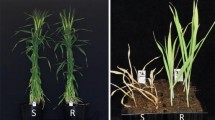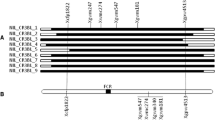Abstract
By essentially fixing the genetic background, near-isogenic lines (NILs) are ideal for studies of the function of specific loci. We report in this paper the development of NILs for a major QTL located on the long arm of chromosome 3B conferring Fusarium crown rot (FCR) resistance in hexaploid wheat. These NILs were generated based on the method of the heterogeneous inbred family analysis. 13 heterozygous lines were initially selected from three segregating populations using a single SSR marker linked with the major FCR QTL. The two isolines for each of the putative NILs obtained showed no obvious morphological differences, but differences among the NIL pairs were large. Significant differences in FCR resistance between the isolines were detected for nine of the 13 putative NIL pairs. The presence of the FCR allele from the resistant parent reduced FCR severity by 29.3–63.9% with an average of 45.2% across these NILs. These NILs will be invaluable in further characterising this major FCR locus, in studying the mechanism of FCR resistance and in investigating possible interactions between FCR resistance and other traits of agronomic importance.
Similar content being viewed by others
References
Akinsanmi OA, Mitter V, Simpfendorfer S, Backhouse D, Chakraborty S (2004) Identity and pathogenicity of Fusarium spp. isolated from wheat fields in Queensland and northern New South Wales. Aust J Agric Res 55:97–107
Bovill WD, Ma W, Ritter K, Collard BCY, Davis M, Wildermuth GB, Sutherland MW (2006) Identification of novel QTL for resistance to crown rot in the doubled haploid wheat population `W21MMT70’ × `Mendos’. Plant Breed 125:538–543
Bovill WD, Horne M, Herde D, Davis M, Wildermuth GB, Sutherland MW (2010) Pyramiding QTL increases seedling resistance to crown rot (Fusarium pseudograminearum) of wheat (Triticum aestivum). Theor Appl Genet 121:127–136
Chakraborty S, Liu CJ, Mitter V, Scott JB, Akinsanmi OA, Ali S, Dill-Macky R, Nicol J, Backhouse D, Simpfendorfer S (2006) Pathogen population structure and epidemiology are a key to wheat crown rot and Fusarium head blight management. Plant Pathol 35:1–13
Kaeppler SM, Phillips RL, Kim TS (1993) Use of near-isogenic lines derived by backcrossing or selfing to map quantitative traits. Theor Appl Genet 87:233–237
Li X, Liu C, Chakraborty S, Manners JM, Kazan K (2008) A simple method for the assessment of crown rot disease severity in wheat seedlings inoculated with Fusarium pseudograminearum. J Phytopath 156:751–754
Li HB, Zhou MX, Liu CJ (2009) A major QTL conferring crown rot resistance in barley and its association with plant height. Theor Appl Genet 118:903–910
Li HB, Xie GQ, Ma J, Liu GR, Wen SM, Ban T, Chakraborty S, Liu CJ (2010) Genetic relationships between resistances to Fusarium head blight and crown rot in bread wheat (Triticum aestivum L). Theor Appl Genet 121:941–950
Liu S, Zhang X, Pumphery MO, Stack RW, Gill BS, Anderson JA (2006) Complex microcolinearity among wheat, rice and barley revealed by fine mapping of the genomic region harbouring a major QTL for resistance to Fusarium head blight in wheat. Funct Integr Genomics 6:83–89
Liu YX, Yang XM, Ma J, Wei YM, Zheng YL, Ma HX, Yao JB, Manners JM, Liu CJ (2010) Plant height affects crown rot severity in wheat (Triticum aestivum L.). Phytopathology 100:1276–1281
Ma J, Li HB, Zhang CY, Yang XM, Liu YX, Yan GJ, Liu CJ (2010) Identification and validation of a major QTL conferring crown rot resistance in hexaploid wheat. Theor Appl Genet 120:1119–1128
Miedaner T, Voss HH (2008) Effect of dwarfing Rht genes on Fusarium head blight resistance in two sets of near-isogenic lines of wheat and check cultivars. Crop Sci 48:2115–2122
Mudge AM, Dill-Macky R, Dong YH, Gardiner DM, White RG, Manners JM (2006) A role for the mycotoxin deoxynivalenol in stem colonisation during crown rot disease of wheat caused by Fusarium graminearum and Fusarium pseudograminearum. Physiol Mol Plant Path 69:73–85
Murray GM, Brennan JP (2009) Estimating disease losses to the Australian wheat industry. Australas Plant Path 38:558–570
Paterson AH, Lander ES, Hewitt JD, Peterson S, Linoln SE, Tanksley SD (1988) Resolution of quantitative traits into Mendelian factors by using a complete linkage map of restriction fragment length polymorphisms. Nature 335:721–736
Paterson AH, DeVerna JW, Lanini B, Tanksley SD (1990) Fine mapping of quantitative trait loci using selected overlapping recombinant chromosomes in an interspecies cross of tomato. Genetics 124:735–742
Pumphrey MO, Bernardo R, Anderson JA (2007) Validating the Fhb1 QTL for Fusarium head blight resistance in near-isogenic wheat lines developed from breeding populations. Crop Sci 47:200–206
Smiley RW, Gourlie JA, Easley SA, Patterson LM, Whittaker RG (2005) Crop damage estimates for crown rot of wheat and barley in the Pacific Northwest. Plant Dis 89:595–604
Tuinstra MR, Ejeta G, Goldsbrough PB (1997) Heterogeneous inbred family (HIF) analysis: a method for developing near-isogenic lines that differ at quantitative trait loci. Theor Appl Genet 95:1005–1011
Young ND, Zamir D, Ganal M, Tanksley SD (1988) Use of isogenic lines and simultaneous probing to identify DNA markers tightly linked to the Tm-2a gene in tomato. Genetics 120:579–585
Acknowledgements
The authors are grateful to Dr John Manners for his critical reading of the manuscript. JM is also grateful to the University of Western Australia for financial support through an International Postgraduate Research Scholarship and the University Postgraduate Awards.
Author information
Authors and Affiliations
Corresponding author
Rights and permissions
About this article
Cite this article
Ma, J., Yan, G.J. & Liu, C.J. Development of near-isogenic lines for a major QTL on 3BL conferring Fusarium crown rot resistance in hexaploid wheat. Euphytica 183, 147–152 (2012). https://doi.org/10.1007/s10681-011-0414-1
Received:
Accepted:
Published:
Issue Date:
DOI: https://doi.org/10.1007/s10681-011-0414-1




